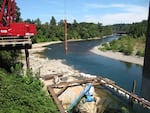
The city of Lake Oswego plans to double the amount of water it takes from the river and is building a larger intake system.
Cassandra Profita
This story is part of an OPB News series, "Clackamas: A River In High Demand."
On a nursery in Boring, Oregon State University researcher Robin Rosetta recently demonstrated a new high-tech pesticide sprayer for a dozen growers.
She explained how the so-called 'smart sprayer' works. It uses a computerized sensor to detect the shape of plants and tell the nozzles on the machine where to spray and where not to spray. The result, she said, is a dramatic reduction in the amount of pesticides sprayed on empty spaces.
Studies by the U.S. Geological Survey have found 63 different pesticides and herbicides in the Clackamas River Basin. And testing shows some of those chemicals are winding up in the drinking water communities take from the river.
Sam Doane sits on the Clackamas River Basin Council, which looks out for water quality. He knows about possible sources of pollution in the water. He's also a horticulturist with Frank J. Schmidt & Son Nursery, and he's working to reduce the potential for pesticide runoff on his land.
“We live in an environment where there are a number of streams and rivers adjacent to the property, and we need to be cognizant of what’s happening in those streams and rivers,” he said.
Doane spent two years testing the smart sprayer at his nursery in the Upper Clackamas River basin. The result was a 65 percent reduction in pesticide use.
“That’s 65 percent less material that has the potential to be an environmental concern,” said Doane.
View Clackamas: A River In High Demand in a larger map
Many miles downstream from Doane’s nursery, Kim Swan is one of the people concerned about pesticides on the Clackamas.
She works for the Clackamas River Water Providers -- a group that represents nearly 400,000 people who rely on the river for drinking water. The group includes the cities of Lake Oswego, West Linn, Oregon City, Estacada, Gladstone, Happy Valley, Damascus and a lot of the surrounding rural communities.
Swan says a lot of her customers think their water is coming from the protected watershed of Portland’s Bull Run.
“The Bull Run is unique because it’s a much smaller watershed and it’s protected. The public doesn’t have access. There’s no agriculture, no logging,” Swan says.
But the Clackamas watershed is different.
“Our watershed, on the other hand, is very large. It’s approximately 940 square miles.”
Swan says that on the many miles upstream from drinking water intakes on the Clackamas, there are nurseries, timberland, wastewater treatment plants, houses with septic systems, golf courses and state and county roads.
Water testing in the river reveals numerous pollutants that could be coming from any of those places. Those pollutants include pesticides, gasoline components and flame retardants. But it’s hard to trace the chemicals to any one source.
For Doane, reduction of pesticide use is one answer... continue the rest of this story (including audio and more photos) at OPB News.
